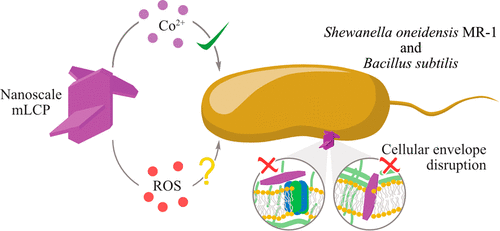当前位置:
X-MOL 学术
›
Chem. Res. Toxicol.
›
论文详情
Our official English website, www.x-mol.net, welcomes your
feedback! (Note: you will need to create a separate account there.)
Cobalt Release from a Nanoscale Multiphase Lithiated Cobalt Phosphate Dominates Interaction with Shewanella oneidensis MR-1 and Bacillus subtilis SB491.
Chemical Research in Toxicology ( IF 3.7 ) Pub Date : 2020-02-18 , DOI: 10.1021/acs.chemrestox.9b00465 Peter L Clement 1 , Joshua E Kuether 2 , Jaya R Borgatta 3 , Joseph T Buchman 1 , Meghan S Cahill 1 , Tian A Qiu 1 , Robert J Hamers 3 , Z Vivian Feng 2 , Christy L Haynes 1
Chemical Research in Toxicology ( IF 3.7 ) Pub Date : 2020-02-18 , DOI: 10.1021/acs.chemrestox.9b00465 Peter L Clement 1 , Joshua E Kuether 2 , Jaya R Borgatta 3 , Joseph T Buchman 1 , Meghan S Cahill 1 , Tian A Qiu 1 , Robert J Hamers 3 , Z Vivian Feng 2 , Christy L Haynes 1
Affiliation

|
Cobalt phosphate engineered nanomaterials (ENMs) are an important class of materials that are used as lithium ion battery cathodes, catalysts, and potentially as super capacitors. As production of these nanomaterials increases, so does the likelihood of their environmental release; however, to date, there are relatively few investigations of the impact of nanoscale metal phosphates on biological systems. Furthermore, nanomaterials used in commercial applications are often multiphase materials, and analysis of the toxic potential of mixtures of nanomaterials has been rare. In this work, we studied the interactions of two model environmental bacteria, Shewanella oneidensis MR-1 and Bacillus subtilis, with a multiphase lithiated cobalt phosphate (mLCP) nanomaterial. Using a growth-based viability assay, we found that mLCP was toxic to both bacteria used in this study. To understand the observed toxicity, we screened for production of reactive oxygen species (ROS) and release of Co2+ from mLCP using three abiotic fluorophores. We also used Newport Green DCF dye to show that cobalt was taken up by the bacteria after mLCP exposure. Using transmission electron microscopy, we noted that the mLCP was not associated with the bacterial cell surface. In order for us to further probe the mechanism of interaction of mLCP, the bacteria were exposed to an equivalent dose of cobalt ions that dissolved from mLCP, which recapitulated the changes in viability when the bacteria were exposed to mLCP, and it also recapitulated the observed bacterial uptake of cobalt. Taken together, this implicates the release of cobalt ions and their subsequent uptake by the bacteria as the major toxicity mechanism of mLCP. The properties of the ENM govern the release rate of cobalt, but the toxicity does not arise from nanospecific effects-and importantly, the chemical composition of the ENM may dictate the oxidation state of the metal centers and thus limit ROS production.
中文翻译:

从纳米级多相锂化钴磷酸盐释放的钴主导了与印度产雪松酵母MR-1和枯草芽孢杆菌SB491的相互作用。
磷酸钴工程纳米材料(ENM)是一类重要的材料,可用作锂离子电池的阴极,催化剂,并有可能用作超级电容器。随着这些纳米材料产量的增加,其释放环境的可能性也随之增加。然而,迄今为止,关于纳米级金属磷酸盐对生物系统影响的研究相对较少。此外,用于商业应用的纳米材料通常是多相材料,并且对纳米材料混合物的毒性潜力的分析很少。在这项工作中,我们研究了两种模式环境细菌,沙瓦氏假单胞菌MR-1和枯草芽孢杆菌,与多相锂化磷酸钴(mLCP)纳米材料的相互作用。使用基于生长的生存力分析,我们发现mLCP对本研究中使用的两种细菌均具有毒性。为了了解观察到的毒性,我们使用三种非生物荧光团筛选了活性氧(ROS)的产生和mLCP中Co2 +的释放。我们还使用了纽波特格林(Newport Green)DCF染料来证明暴露于mLCP后细菌吸收了钴。使用透射电子显微镜,我们注意到mLCP与细菌细胞表面无关。为了进一步探讨mLCP的相互作用机理,将细菌暴露于等量的从mLCP溶解的钴离子中,从而重现了当细菌暴露于mLCP时活力的变化,并且还概括了观察到的细菌吸收钴。在一起 这暗示了钴离子的释放以及细菌随后对其的吸收是mLCP的主要毒性机理。ENM的特性决定了钴的释放速率,但毒性不是由纳米特异性作用引起的,重要的是,ENM的化学成分可能决定金属中心的氧化态,从而限制了ROS的产生。
更新日期:2020-02-19
中文翻译:

从纳米级多相锂化钴磷酸盐释放的钴主导了与印度产雪松酵母MR-1和枯草芽孢杆菌SB491的相互作用。
磷酸钴工程纳米材料(ENM)是一类重要的材料,可用作锂离子电池的阴极,催化剂,并有可能用作超级电容器。随着这些纳米材料产量的增加,其释放环境的可能性也随之增加。然而,迄今为止,关于纳米级金属磷酸盐对生物系统影响的研究相对较少。此外,用于商业应用的纳米材料通常是多相材料,并且对纳米材料混合物的毒性潜力的分析很少。在这项工作中,我们研究了两种模式环境细菌,沙瓦氏假单胞菌MR-1和枯草芽孢杆菌,与多相锂化磷酸钴(mLCP)纳米材料的相互作用。使用基于生长的生存力分析,我们发现mLCP对本研究中使用的两种细菌均具有毒性。为了了解观察到的毒性,我们使用三种非生物荧光团筛选了活性氧(ROS)的产生和mLCP中Co2 +的释放。我们还使用了纽波特格林(Newport Green)DCF染料来证明暴露于mLCP后细菌吸收了钴。使用透射电子显微镜,我们注意到mLCP与细菌细胞表面无关。为了进一步探讨mLCP的相互作用机理,将细菌暴露于等量的从mLCP溶解的钴离子中,从而重现了当细菌暴露于mLCP时活力的变化,并且还概括了观察到的细菌吸收钴。在一起 这暗示了钴离子的释放以及细菌随后对其的吸收是mLCP的主要毒性机理。ENM的特性决定了钴的释放速率,但毒性不是由纳米特异性作用引起的,重要的是,ENM的化学成分可能决定金属中心的氧化态,从而限制了ROS的产生。











































 京公网安备 11010802027423号
京公网安备 11010802027423号